

Recruitment Processes: Ichthyoplankton Dynamics Project
The Ichthyoplankton Dynamics Project seeks to gain an understanding of the complex and dynamic relationships between young fishes and their physical environment. In particular, we are interested in the endogenous and exogenous factors that mediate the behavior and ecology of larvae and early juveniles of economically and ecologically important fish species. We conduct retrospective and process-oriented work to examine the effects of climate forcing and ecosystem shifts on biology and ecology of ichthyoplankton and zooplankton in the Gulf of Alaska and Bering Sea. This work has direct application to current issues in marine fish ecology and the management of living marine species, such as assessing the effects of climate change on larval and juvenile fish populations, understanding sources of variation in year class strength, and evaluating potentially important fish nursery areas (essential fish habitat).
Current studies:
Transport of Flatfish Larvae in the Eastern Bering Sea
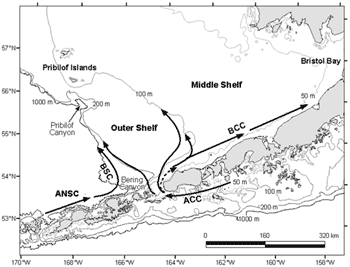 Work in this area focuses on the complex processes that regulate the dispersal of larvae over the Bering Sea slope and shelf, and the eventual recruitment of late-stage flatfish larvae and juveniles to inshore nursery areas. This ongoing project seeks to better understand how physical drift is mediated by larval behavior and physiology. These investigations utilize empirical approaches such as depth-discrete sampling and deployment of satellite-tracked drifters, coupled with biophysical modeling. The goals of the work are to determine transport pathways for larvae, to elucidate divergences from passive particle-predicted transport trajectories, and to extrapolate possible effects of climate-induced shifts on distribution of larval and juvenile flatfishes. Work in this area focuses on the complex processes that regulate the dispersal of larvae over the Bering Sea slope and shelf, and the eventual recruitment of late-stage flatfish larvae and juveniles to inshore nursery areas. This ongoing project seeks to better understand how physical drift is mediated by larval behavior and physiology. These investigations utilize empirical approaches such as depth-discrete sampling and deployment of satellite-tracked drifters, coupled with biophysical modeling. The goals of the work are to determine transport pathways for larvae, to elucidate divergences from passive particle-predicted transport trajectories, and to extrapolate possible effects of climate-induced shifts on distribution of larval and juvenile flatfishes.
Links between Ichthyoplankton Dynamics and Physical Aspects of the Ecosystem in the Northwest Gulf of Alaska
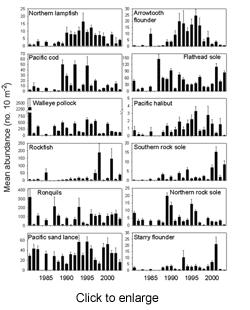 The present study focuses on a 21-year time-series in abundance of numerically dominant larval fish species in late spring ichthyoplankton surveys from 1981 through 2003 in the northwest Gulf of Alaska (GOA). In combination with basin and local-scale measures of the state of the atmosphere and ocean during these years, these ichthyoplankton data offer an important opportunity for exploring multispecies links between fish early life history dynamics and the physical environment in the GOA. The principal objectives of this study are to document interannual patterns of variation in abundance of the numerically dominant larval fish species in the GOA during late spring and to investigate links between the larval abundance patterns and time-series of physical oceanographic and climate variables. Generalized additive models have been used to investigate the links between the late spring larval abundance patterns and the oceanographic and climate variables. Among-species synchronicity in the larval abundance time-series, and in the species to physical variable connections, has been identified. Links between the species and the physical variables are interpreted from the perspective of fish life history strategies and potential physical forcing on early life history aspects of recruitment dynamics in the Gulf of Alaska ecosystem. The present study focuses on a 21-year time-series in abundance of numerically dominant larval fish species in late spring ichthyoplankton surveys from 1981 through 2003 in the northwest Gulf of Alaska (GOA). In combination with basin and local-scale measures of the state of the atmosphere and ocean during these years, these ichthyoplankton data offer an important opportunity for exploring multispecies links between fish early life history dynamics and the physical environment in the GOA. The principal objectives of this study are to document interannual patterns of variation in abundance of the numerically dominant larval fish species in the GOA during late spring and to investigate links between the larval abundance patterns and time-series of physical oceanographic and climate variables. Generalized additive models have been used to investigate the links between the late spring larval abundance patterns and the oceanographic and climate variables. Among-species synchronicity in the larval abundance time-series, and in the species to physical variable connections, has been identified. Links between the species and the physical variables are interpreted from the perspective of fish life history strategies and potential physical forcing on early life history aspects of recruitment dynamics in the Gulf of Alaska ecosystem.
Ichthyoplankton abundance, distribution and assemblage structure
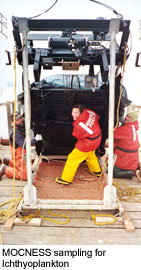 We are examining historical ichthyoplankton data collected in the Gulf of Alaska and eastern Bering Sea for spatial and temporal patterns in abundance, distribution and assemblage structure. Emergent patterns are explored in relation to key bathymetric, hydrographic, and life history variables. In particular, punctuated effects of mesoscale climate variations on species associations, species sensitivities, and species responses are of interest. Work to date suggests that larval and juvenile fishes may be timely indicators of environmental change. We are examining historical ichthyoplankton data collected in the Gulf of Alaska and eastern Bering Sea for spatial and temporal patterns in abundance, distribution and assemblage structure. Emergent patterns are explored in relation to key bathymetric, hydrographic, and life history variables. In particular, punctuated effects of mesoscale climate variations on species associations, species sensitivities, and species responses are of interest. Work to date suggests that larval and juvenile fishes may be timely indicators of environmental change.
Factors affecting larval capelin distribution
We are studying the vertical and horizontal distribution of capelin, an ecologically important species for trophic connections in the Gulf of Alaska and Bering Sea. General Additive Models are being used to identify biotic and abiotic factors that may affect larval capelin vertical and horizontal distribution. Potential factors include prey densities, illumination, tidal flow, temperature, salinity, and depth. This project may provide insight into mechanisms of larval capelin transport from inter-tidal spawning areas to nursery areas over the continental shelf.
Evaluation of Neuston Sampling Gear
This project evaluates the sampling efficiency of various gear types to sample the neustonic layer in the Gulf of Alaska. Evaluation criteria include comparing ichthyoplankton abundances, ichthyoplankton assemblage diversities, and larval lengths. Field-collected data indicate that there are differences in the sampling efficiencies of the three gear types tested (MANTA, MARMAP, Sameoto). Based on these results, choice of gears should be considered depending on whether the primary objective is to obtain estimates of abundance, diversity, or length.
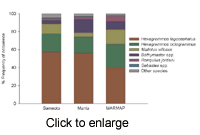
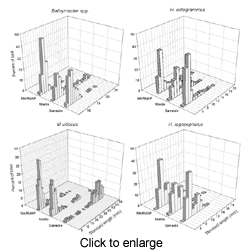
|
Recent Publications, Poster Presentations, Reports & Activities |
-
ABOOKIRE, A. A., J. T. DUFFY-ANDERSON, and C. M. JUMP. 2007. Habitat associations and diet of young-of-the-year Pacific cod (Gadus macrocephalus) near Kodiak, Alaska. Mar. Biol. 50(4):713-726.
-
BOEING, W., M. MARTIN, and J. T. DUFFY-ANDERSON. 2007. Groundfish: status and mechanisms of change. In: Long-term Ecological Change in the Northern Gulf of Alaska. Spies, R. (ed.). Elsevier. Pp.300-311.
-
DUFFY-ANDERSON, J. T., M. S. BUSBY, K. L. MIER, C. M. DELIYANIDES, and P. J. STABENO. 2006. Spatial and temporal patterns in summer ichthyoplankton assemblages on the eastern Bering Sea shelf 1996-2000. Fish. Oceanogr. 15:80-94.
-
LANKSBURY, J. A., J. T. DUFFY-ANDERSON, K. L. MIER, M. S. BUSBY, and P. J. STABENO. 2007. Distribution and transport patterns of northern rock sole, Lepidopsetta polyxystra, larvae in the southeastern Bering Sea. Prog.Oceanogr. 72:39-62.
-
DUFFY-ANDERSON, J. T., K. BAILEY, L. CIANNELLI, P. CURY, A. BELGRANO, and N. C. STENSETH. 2005. Phase transitions in marine fish recruitment processes. Ecol. Complex. 2:205-218.
|
To view and print these documents, you must install
Adobe Reader freeware. Adobe also offers
free tools for the visually disabled.
|